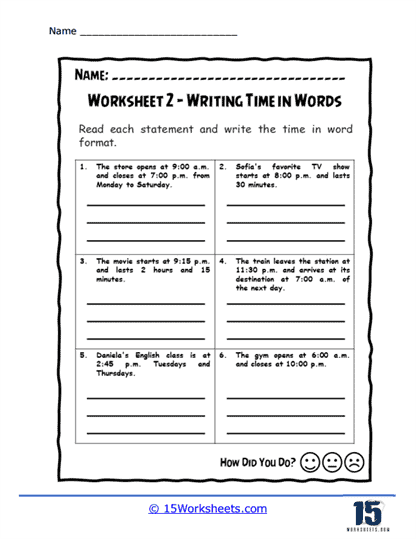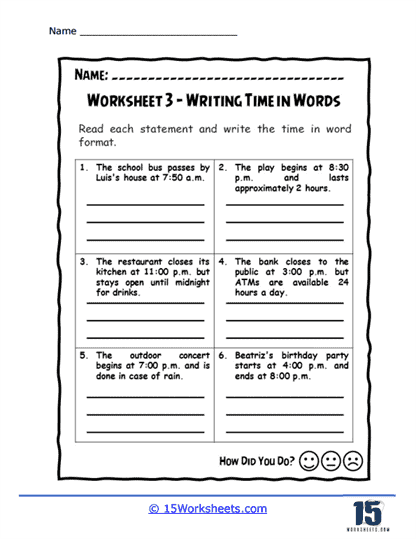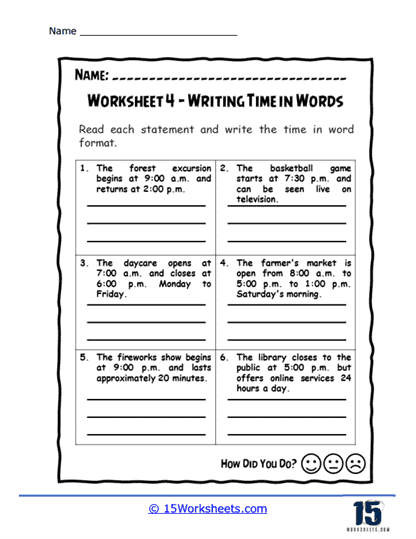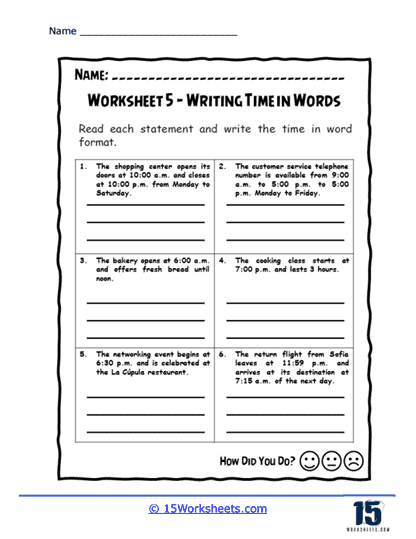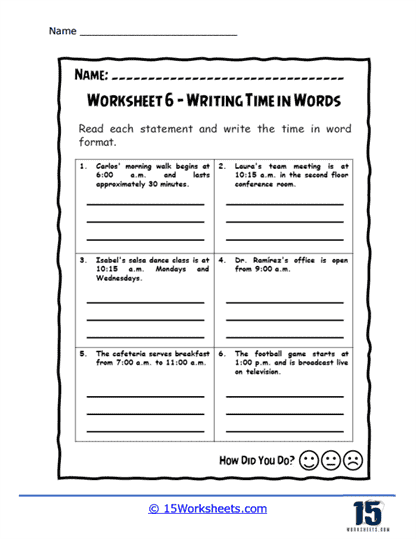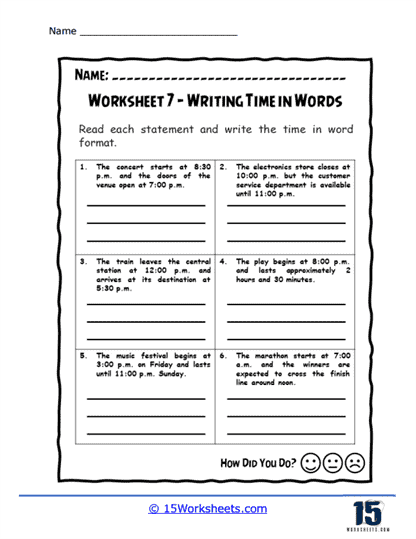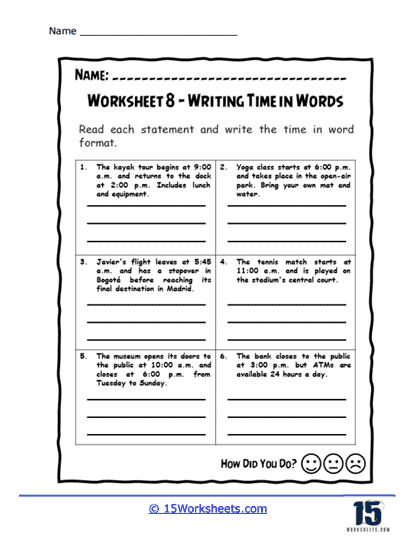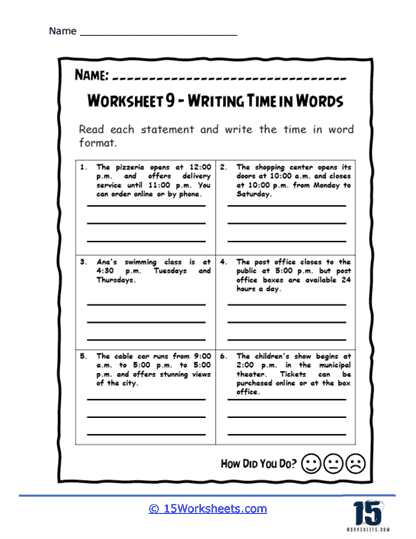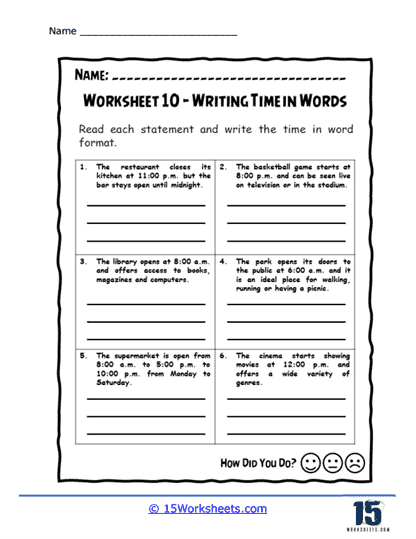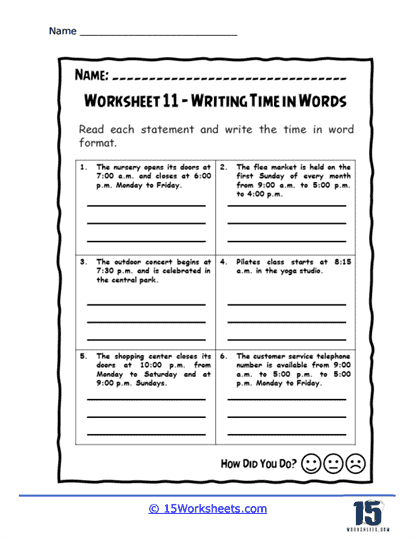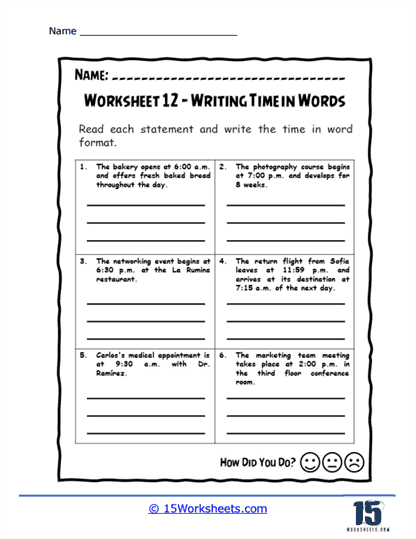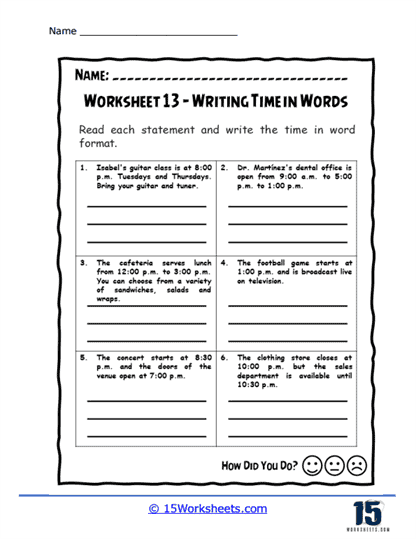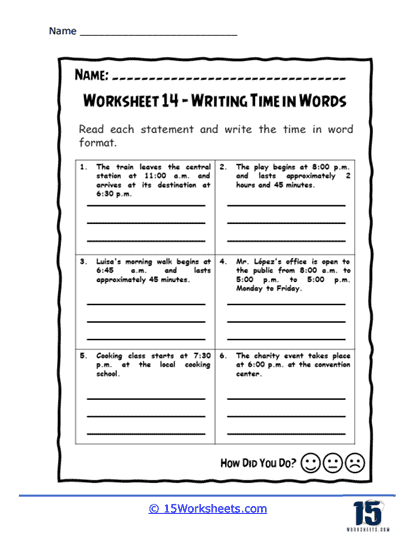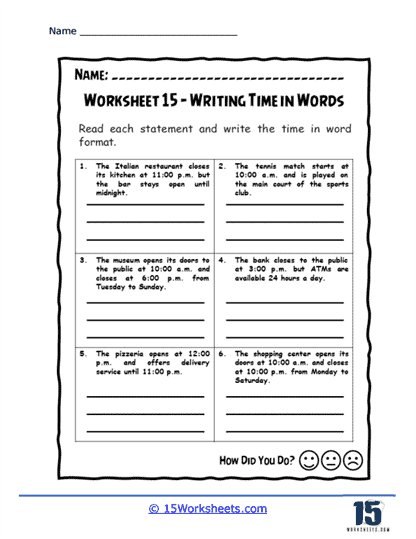Writing Time in Words Worksheets
About These 15 Worksheets
These worksheets can help students practice converting numerical times into written word format. These worksheets are essential in developing students’ ability to read and write times accurately, a fundamental skill in both academic and real-world contexts. By presenting times in various scenarios, these worksheets make learning interactive and relatable, helping students see the practical applications of their math skills in everyday life.
Mathematical Skills Explored
These worksheets cover a variety of mathematical skills that are essential for understanding and interpreting time. These skills encompass a range of topics including number recognition, sequencing, and the understanding of time-related vocabulary.
They emphasize number recognition and sequencing. Students need to be able to identify and write numbers correctly to represent hours and minutes accurately. This involves not just knowing numbers but also understanding their order and how they relate to each other in the context of a clock. For example, recognizing that 5 comes after 4 and before 6, or that 15 minutes is a quarter past the hour.
Comprehension of time-related vocabulary is a key skill addressed in these worksheets. Students must learn terms such as “o’clock,” “quarter past,” “half past,” and “quarter to,” which are fundamental for expressing time in words. Understanding these phrases requires a grasp of fractions and their relation to time. For example, knowing that “quarter past” refers to 15 minutes after the hour and “half past” to 30 minutes after the hour.
These worksheets often incorporate the skill of converting between different formats of time expression. Students may need to translate a time given in numerical form (e.g., 3:45) into words (e.g., “quarter to four”). This conversion requires not only an understanding of how to read an analog clock but also familiarity with the language used to describe time.
Exercises on These Worksheets
One common type of exercise is the basic time-telling problem. These exercises present students with an image of an analog clock showing a specific time. The students are then required to write down the time in words. For instance, a clock showing 3:00 would need to be written as “three o’clock,” while a clock showing 3:15 would be written as “quarter past three.” These exercises help students practice reading clock faces and converting the visual information into the correct verbal format.
Another frequent exercise involves matching times. Students might be given a list of times written in numerical form alongside a separate list of times written in words. Their task is to draw lines connecting the matching pairs. This type of exercise reinforces the connection between numerical and verbal representations of time, helping students become more fluent in switching between the two formats.
You will also find that the worksheets include exercises that require students to fill in missing words. These might present a partially completed sentence, such as “It is half ___ twelve,” where students must correctly fill in the blank with the appropriate word, in this case, “past.” Such activities emphasize the correct use of time-related vocabulary and ensure that students are familiar with common phrases used to express different times.
You will find more complex problems that involve advanced calculations. For example, students might be asked to determine what time it will be in a certain number of minutes or hours from a given starting time. For instance, if the current time is 2:00, what time will it be in 45 minutes? These problems require students to use their addition skills and understand the concept of time increments, enhancing their problem-solving abilities.
The Benefits Of These Worksheets
Learning how to write time in words offers several key educational benefits. It enhances a student’s comprehension of numbers and sequences. By converting numerical times into written words, students reinforce their understanding of numerical order and the relationships between different units of time. This practice strengthens their overall number literacy, which is foundational for more advanced mathematical concepts.
Writing time in words helps develop a student’s language and vocabulary skills. Learning terms such as “quarter past,” “half past,” and “quarter to” not only expands their time-related vocabulary but also improves their ability to use descriptive language accurately. This skill is important for clear communication, both in academic settings and everyday interactions.
This type of practice improves cognitive skills such as memory and mental math. When students regularly engage in writing times in words, they become more adept at quickly and accurately interpreting the position of the hands on a clock and translating that information into words. This exercise enhances their mental arithmetic capabilities and helps them to develop quicker recall of time-related information.
Real World Application Of This Skill
In the real world, the ability to write time in words is a practical skill that is used in various contexts. In education and professional settings, clear communication of time is essential for scheduling meetings, deadlines, and events. For instance, saying “The meeting is at half past three” is often clearer in verbal communication than saying “The meeting is at 3:30,” especially in situations where the listener may not be familiar with digital time formats.
This skill is crucial in certain professional fields. For example, in healthcare, precise communication about time can be critical. Medical professionals often need to record and communicate the times of patient appointments, medication schedules, and procedural timings in both written and spoken forms. Writing time in words ensures there is no confusion or misinterpretation, which is essential for patient safety.
In everyday life, writing time in words aids in social interactions and personal time management. When coordinating plans with friends and family, being able to clearly articulate times helps ensure everyone is on the same page. It also plays a role in literacy and helps individuals better understand and follow written instructions or schedules that use time expressed in words, such as event invitations or transportation timetables.
Example Problem – Sarah’s birthday party starts at 2:30 p.m. and ends at 5:00 p.m. Write the start and end times in words.
Step-by-Step Solution
1. Identify the start time
– The start time is 2:30 p.m.
2. Write the start time in words
– 2:30 p.m. is written as “two thirty in the afternoon.”
3. Identify the end time
– The end time is 5:00 p.m.
4. Write the end time in words
– 5:00 p.m. is written as “five o’clock in the evening.”
5. Final Answer
– Start time: two thirty in the afternoon
– End time: five o’clock in the evening
Sarah’s birthday party starts at two thirty in the afternoon and ends at five o’clock in the evening.


